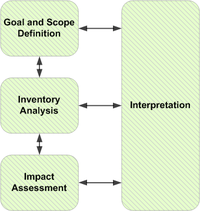
Photo from wikipedia
Abstract Building life cycle assessment (LCA) aims at guiding decision towards more sustainable alternatives of a building project. But, in order to successfully reduce the high environmental impacts of the… Click to show full abstract
Abstract Building life cycle assessment (LCA) aims at guiding decision towards more sustainable alternatives of a building project. But, in order to successfully reduce the high environmental impacts of the building sector, the results of building LCA have to be robust. Sensitivity analysis (SA) helps at investigating the sources of uncertainty and variability in a model and assessing the results' robustness. Choosing an adapted SA method remains difficult: using the more precise SA methods would require a too large calculation time, particularly for an application in early design phase. In this paper, the most influential factors of building LCA tools, linked with energy simulation tools, were investigated using screening and global SA methods that are compatible with the building LCA fields. The relative influence of the uncertain factors served as a metric to compare more precisely the results given by this large panel of methods. The results show that despite their different precision vs computational cost compromises, all the methods identified the same set of influential factors. In the studied case of a passive single family house, they consisted in the building lifetime, the electricity production mix and factors affecting the energy consumption. However, the relative influence of the factors differed. Two new method adaptations were investigated in order to obtain precise results in a reasonable simulation time. The adaptation of the Plackett and Burman (PB) screening performed well compared to the reference method (Sobol indices), as the same set of influential factors was always identified in a calculation time divided by almost 30.
Journal Title: Journal of Cleaner Production
Year Published: 2018
Link to full text (if available)
Share on Social Media: Sign Up to like & get
recommendations!